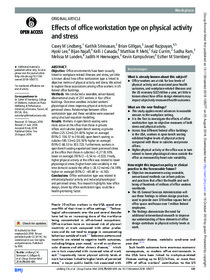Effects of office workstation type on physical activity and stress

Lindberg, Casey M. ; Srinivasan, Karthik ; Gilligan, Brian ; Razjouyan, Javad ; Lee, Hyoki ; Najafi, Bijan ; Canada, Kelli J. ; Mehl, Matthias R. ; Currim, Faiz ; Ram, Sudha ; Heerwagen, Judith H. ; Kampschroer, Kevin ; Sternberg, Esther M.
Occupational and Environmental Medicine
2018
75
10
689-695
office work ; workplace design ; stress ; sitting posture ; occupation disease relation ; sick leave ; cost of diseases
Ergonomics and work environment
http://dx.doi.org/10.1136/oemed-2018-105077
English
Bibliogr.
"Objective
Office environments have been causally linked to workplace-related illnesses and stress, yet little is known about how office workstation type is linked to objective metrics of physical activity and stress. We aimed to explore these associations among office workers in US federal office buildings.
Methods
We conducted a wearable, sensor-based, observational study of 231 workers in four office buildings. Outcome variables included workers' physiological stress response, physical activity and perceived stress. Relationships between office workstation type and these variables were assessed using structural equation modelling.
Results
Workers in open bench seating were more active at the office than those in private offices and cubicles (open bench seating vs private office=225.52 mG (31.83% higher on average) (95% CI 136.57 to 314.46); open bench seating vs cubicle=185.13 mG (20.16% higher on average) (95% CI 66.53 to 303.72)). Furthermore, workers in open bench seating experienced lower perceived stress at the office than those in cubicles (−0.27 (9.10% lower on average) (95% CI −0.54 to −0.02)). Finally, higher physical activity at the office was related to lower physiological stress (higher heart rate variability in the time domain) outside the office (−26.12 ms/mG (14.18% higher on average) (95% CI −40.48 to −4.16)).
Conclusions
Office workstation type was related to enhanced physical activity and reduced physiological and perceived stress. This research highlights how office design, driven by office workstation type, could be a health-promoting factor."
Digital
The ETUI is co-funded by the European Union. Views and opinions expressed are however those of the author(s) only and do not necessarily reflect those of the European Union or the ETUI.